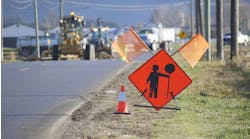In the nearly 65 years since President Eisenhower spurred the creation of the modern interstate system, U.S. transportation infrastructure has transformed from a smattering of local roadways to a modern network of interconnected highways.
Along with this development of the nation’s roadways came a transformation and standardization in roadway safety protocols as well – improvements like guardrails, signage, traffic markings and median barriers that are now ubiquitous on U.S. roads.
As the roadway safety infrastructure industry looks toward future advancement – technology like connected and automated vehicles (CAVs) and intelligent transportation systems (ITS), for example – industry advocacy organizations are working to ensure the U.S. is prepared to identify and implement the demands of a more modernized infrastructure.
Technology Driving Infrastructure Advancement
Technological advances in vehicles and infrastructure are driving many of the changes. States are beginning to transition from 4 inch lane lines to 6 inch lines to better delineate the lanes of travel and provide improved performance of CAVs. ITS systems can now identify and report when a wrong way driver enters the freeway.
“Transportation agencies are using vehicle and pedestrian actuated signs/devices to help reduce the frequency of incidents that can result in fatal and serious injury crashes,” said Priscilla Tobias, Illinois operations manager for Arora and Associates, PC. “For pedestrians, technology has advanced where once a pedestrian is detected, a crosswalk can be illuminated, providing for increased visibility of pedestrians crossings at night.”
Advancing Roadway Safety with Federal and State Legislation
Roadway safety standards would not have come about without advocacy from the roadway safety industry. Organizations like the American Traffic Safety Services Association (ATSSA) work closely with government officials at the federal and state levels to ensure that roadway safety legislation and standards keep pace with industry needs. Not only does ATSSA provide advocacy through lobbying efforts on Capitol Hill and at the association’s annual Legislative Briefing & Fly-In, it also brings members of congress to events to discuss ways to improve roadway safety and its infrastructure locally.
“ATSSA has become a voice for its members when it comes to dealing with federal, state, and local issues,” said Lawrence Boise, president and CEO of Franklin Paint Company Inc. ATSSA is a voting member of the National Committee on Uniform Traffic Control Devices and participates on each technical committee to provide input into the development of the Manual on Uniform Traffic Control Devices.
“These standards provide information to the practitioner on safe and effective ways to deploy traffic control devices,” said Eric Perry, ATSSA director of innovation and technical services. “In our Association’s mission, to advance roadway safety, we provide input to these types of organizations to move toward zero fatalities in the United States.”
Training for Technological Advancement
Training and curriculum help provide technology information for members of the transportation infrastructure industry, create a consistent standard throughout the United States to improve roadway safety and help establish and foster a national dialogue on new technologies and how they will be standardized. Since 2002, ATSSA has trained nearly 1 million people in these standards.
“It is vital that the industry keep pace with the changing technologies and regulations within the roadway safety industry,” said Donna Clark, ATSSA vice president of member services. “ATSSA develops and delivers curriculums that reflects these needs.”
Looking Toward the Future of Roadway Safety
As the industry continues to innovate to improve roadway safety infrastructure, it will need to address challenges, including the need for more comprehensive sustainable highway funding for projects and finding more efficient ways for products to be reviewed and approved.
“The industry is struggling with the highway bills and funding are always being fought over,” said John Durkos, vice president of technical support and marketing for Road Systems Inc. “For product owners to do the same things 50 different times and 50 different ways for each [department of transportation] DOT and then face the uncertainty of the [Manual for Assessing Safety Hardware] MASH implementation status in front of us has hindered progress.”
Despite the challenges facing the industry, ATSSA is committed to partnering with stakeholders across the industry to push forward on the national goal of eliminating roadway fatalities by moving Toward Zero Deaths.



